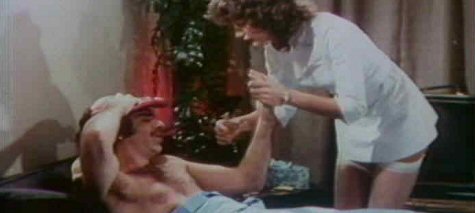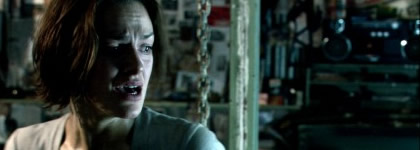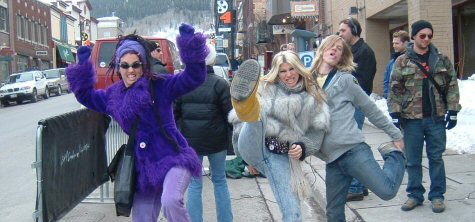I came to chortle at Inside Deep Throat and, to be honest, maybe feel a tiny bit excited by it…but I came away feeling leveled-out, sobered-up, un-randy.
Sobered up doesn’t mean bummed, which is how I pretty much felt after seeing Deep Throat itself. It was such a shitty movie…so cheesy, stupid, clueless. But it made raunch seem hip for that five- or ten-minute period in `72 or ’73 with the New York Times-propagated concept of “porno chic.”

Okay, there was something cool and, of course, basically harmless about middle-class couples, single women and other atypical patrons lining up in front of porn theatres to see this film way back when…brazen, liberating, vaguely revolutionary…but from today’s perspective there’s something about it that seems a bit odious.
What did Fear of Flying author Erica Jong once say about watching porn? “After a minute or so, I want to find a partner and immediately have sex. But after watching for ten minutes, I never want to have sex again.”
A woman friend of mine didn’t want to go to a recent screening of Randy Barbato and Fenton Bailey‘s 90 minute documentary, which will have its big debut on Friday night at the Sundance Film Festival, because she hates the Deep Throat legend and metaphor, and assumed the doc would be flip and snickering.
It’s not. It’s actually something a conservative-thinking prude could be okay with, as it passes along information here and there that would support the view that pornography is basically demonic. It also passes along the view that it’s all pretty harmless and that the anti-porn forces are a fairly tedious bunch. And it is fairly funny here and there.

The drugstore toupee that Deep Throat‘s writer-director-producer Gerard Damiano wears during his interview says it all, if you ask me.
Inside Deep Throat, which reportedly wouldn’t have been made without the obsessive interest in the subject by producer Brian Grazer, follows the story of the most profitable film of all time right into the scuzzy deep pockets of the mafia, the reactionary mentality of Nixon-era politicians and prosecutors, the ready-teddy libido of the American public in the early `70s and the sadnesses of Linda Lovelace and Harry Reems.
The commentators include Throat‘s Damiano, some of his former cronies, two or three prosecutor or law-enforcement types, Jong, Reems, a friend of Lovelace’s along with a disapproving sister, two or three guys who showed the legendary film in their theatres in the early `70s, Georgina Spelvin, Susan Brownmiller, disco singer Andrea True (“More, More, More”), John Waters, Camille Paglia, Gore Vidal and Norman Mailer.
If there’s a single message than comes through, it’s that working in pornography always seems to lead to great unhappiness and regret for the performers. This point was made by Paul Thomas Anderson‘s Boogie Nights, I think, and seems pretty much supported by facts.
I don’t think anyone needs to be reminded that porn actors and filmmakers are, 96% of the time, staggeringly un-talented people, which of course is what makes porn films so godawful to sit through, but there’s no escaping this observation, in any event.
Barbato and Bailey explore Damiano’s making of the flick in South Florida, the diseased relationship between Lovelace and her psychotic boyfriend (i.e., a control freak who taught her the deep-throat technique), the cultural reaction after the film started to get around in respectable circles, the legal attacks upon it (and particularly upon Reems, who was facing five years in jail in the mid ’70s simply because he acted in it), Lovelace’s difficult, somewhat sad life in the `80s and `90s (she died in a car crash in ’02), and Reems’ descent into alcoholism until he swore off booze and converted to Christianity in the mid `90s.

Reems is today a successful real-estate broker based in Park City, Utah, which of course places him right smack dab in the middle of this year’s Sundance festival. I impulsively called Reems on my cell phone right after Monday night’s screening, and damned if he didn’t pick up. We’re supposed to talk sometime this weekend.
The best material comes from an elderly Florida distributor (forgotten his name, notes weren’t provided) who played Throat and ran afoul of some South Florida goombahs who threatened everyone involved so as to grab an inordinate share of the box-office. While he’s talking to the camera, his wife sits some 20 or 30 feet away and crabs about how he should stop talking, because she’s still afraid of the mob guys.
A New York journalist friend who saw Inside Deep Throat two days ago called it “fun and fascinating, if a little too glib. It’s amazing who they dug up — Reems, Damiano, Spelvin, True. But too many of the pro-First Amendment types seem like the usual suspects: Hefner, Paglia, Waters, Vidal.
“The film delves into the hugeness of porn today, but it has nothing to say about the pornofication of the culture,” he added.
He’s right — the doc could have made more out of this. It could have explored the various forms of pornography that have become commonplace. Pornography has arguably become the dominant social metaphor of our times. It seeps out of every cultural pore, out of nearly every act of mass-media attention-getting.

Paris Hilton is a pornographic manifestation, and I’m not even referring to her sex tape.
Mary Hart, Pat O’Brien and Jann Carl of Entertainment Tonight are pornographers of a mainstream, glitzy stripe.
Every day, I believe, I’m confronted with architectural pornography on the streets of Los Angeles.
It’s gotten so that porn’s least pernicious aspect, by far, is the sexual. Internet porn (especially the amateur stuff) seems so innocuous and inoffensive alongside corporate-level porn that it doesn’t bear mentioning in the same breath.
It Begins Again
Every year five or six films first seen at the Sundance Film Festival punch through and become movies that regular ticket-buyers want to see, or at least feel they should try to catch up with. Or is the number more like seven or eight?
It may be a tad higher this year. I’m envisioning — hearing about — eleven films, give or take, although I’m presuming at least two or three of these will fall on their face. Two or three others not showing up on anyone’s lists right now will also pop through, if previous history means anything.
Hustle & Flow, absolutely. The Chumscrubber. Wolf Creek, for sure. The Dying Gaul….but one should always be wary of a movie with the word “dying” in its title, as it always seems to promise moroseness and downer `tudes. The Aristocrats….possibly. The Jacket . Layer Cake, definitely. Dirty Love, but it sounds extremely shallow. Maybe The Matador.


And The Upside of Anger, for sure, because I’ve seen it and I know it plays in a way that will fare pretty well with general audiences. (Especially due to Kevin Costner’s extremely ingratiating performance.) And Sebastian Cordero’s Cronicas, which I wrote about last Friday.
It’s not like I’m the hippest guy in the room or anything. Most of the handicappers have mentioned these titles in some fashion. But I’ve heard from two acquisitions executives that Hustle & Flow is one to see, and I’m picking up radio-wave signals about it besides, so that’s my big pick of the litter.
I used to call around and try to zero in on the hot tickets in advance, and I’d usually end up being about 60% right…sometimes. But it wouldn’t matter because the films that are fated to penetrate have a certain unstoppable energy about them, and recognition of this always happens with or without my being ahead of the game or not, so who cares? None of it matters. Okay, some of it does.
I’m acknowledging that for most people, reading about Sundance activity — the focus of part of today’s column, as well as the next four (I’ll be running three columns next week instead of the usual two) — is of some interest, and I think it should be paid attention to, but it’s a bit of an insular industry experience. Fun to attend and write about, but….well, let’s leave it at that.


My plane leaves today around 2 pm, I’ll be in the Park City condo by 6 pm or so, off to Robertson’s for groceries by 7 pm, and then over to a private little dinner party being thrown by Paramount Classics honcho Ruth Vitale at her Deer Valley home.
And then the mess-around starts Thursday afternoon.
I’m going to try and file something on Friday. Photos and some random observations about whatever’s moving at the moment is about all I can manage. I’m going to try and work in an appreciation of Sharon Waxman’s smooth and highly readable Rebels on the Backlot (Harper), which is being celebrated at a party in Park City on Monday afternoon.
Rundown
I called one of my regular sources the other day, and she insisted the whole Sundance shakedown is right there in the pages of program guide.
You just have to know how to decode the smoothly bizarre press prose (Note: by the official aesthetic appreciation standards of Gilmore, John Cooper, Shari Frillot, Diane Weyerman, Trevor Goth, etc., any film can be made to sound artistically worthy and intriguing…even Catwoman) and be up on the recent history of the filmmakers, especially the producers.
Hustle & Flow stars the excellent but relatively unsung Terrence Howard (who had a stand-out second-banana role in Ray, and will be seen in Paul Haggis’ Crash as well as in the Sundance Premiere selection Lackawanna Blues). Directed and written by Craig Brewer, and shot in and around Memphis, it’s about a pimp trying to break out and become a successful rapper. Jim Sheridan is currently cooking up a similar-sound film about the struggle of 50 Cent trying to leave behind a life of crime, etc.

The Aristocrats, a documentary, has been described by Gilmore in the Sundance program notes as “one of the most shocking and, perhaps for some, offensive films you will ever see.” Penn Jillette and Paul Provenza’s film shows the same filthy joke being told more than 100 times. Repetition dulls the point of anything, so how can such a film live up to Gilmore’s description? A lot of folks will want to see it anyway, I imagine, give the hype.
Oh, jeez…it’s 10:30 already. My plane is leaving in less than three hours and I can’t even finish this. Terrific.
Well, just go to the Sundance site (www.sundance.org) and read what you can. Like I said, I’ll start checking in on Friday and we’ll just take it, film by film. I’ve got a party list and between tomorrow night and Thursday, 1.27, it looks as if at least 56 parties (all lavishly catered, and probably costing tens of thousands each) will be thrown.
Avoid `Ems
I’ve already said I’m against seeing Thumbsucker on general principle, as I loathe the idea of watching a film about a young guy (Lou Pucci) with…I don’t even want to think about it. If someone make a movie some day about a guy who can’t stop picking his nose, I’ll try to avoid that one also.

9 Songs — Michael Winterbottom’s low-budgeter has sex scenes that are almost as bad as anything I’ve ever seen in a straight porn film, plus some very slip-shod concert footage. An almost totally worthless film with actors, on top of everything else, who aren’t even especially attractive with their clothes off.
The Ballad of Jack and Rose — Decently made, intelligently conceived and executed, and boasting another first-rate Daniel Day Lewis performance (is there any other kind?) …but too quirky and oddball for my tastes. There’s a repressed father-daughter incest angle that doesn’t quite manifest, or at the least is insufficiently developed.
Talent Roster
I thought I’d throw in a plug for the recently re-jiggered Discland column, which is now being edited by Jonathan Doyle, plus a note or two about Doyle and the contributors:
Jonathan Doyle recently completed his Masters degree in Film Studies at Concordia University in Montreal, Quebec, Canada. He is the founder and webmaster of the Jonathan Demme website, Storefront Demme (www.storefrontdemme.com) and a programmer for The Fantasia Film Festival, a popular showcase for Asian films, horror films, and other assorted weirdness. He has also written film criticism for countingdown.com and the Canadian film journal, Synoptique. In spite of Jeffrey Wells’ disapproval, he is proud to call The Life Aquatic and The Aviator his favorite films of 2004.
Jason Comerford is a graduate of the North Carolina School of the Arts’ School of Filmmaking, class of `01. He is currently working for Erwin-Penland Advertising as a copywriter/proofreader, while also working as a journalist. His recent pieces include a lengthy review of The Passion of the Christ and tributes to Jerry Goldsmith and Elmer Bernstein for Film Score Monthly.

Christopher Hyatt is a lifelong movie buff living in Chicago with a taste for films that go off the beaten track in terms of style, subject matter, and sensibility, a taste that leads him in all sorts of directions film-wise. As far as DiscLand is concerned, he hopes this will make him “a voice for lovers of cult and offbeat films.” He is also a longtime reader of this column, going back to the reel.com days, and is taking his first baby steps toward becoming a filmmaker, himself.
At only 23, Joey Tayler is the youngest member of the DiscLand team. After graduating from Marquette University two years ago, he began working as a film critic for the Waukesha Freeman, one of the largest newspapers in suburban Milwaukee. He also works as an assistant producer at a local film production outfit. Despite all that, he’s still got too much time on his hands and loves writing about film. His least favorite film of 2004 was Dogville.
“Other writers are waiting in the wings and, as their writing is posted in the weeks to come, the column will expand and move in new and unexpected directions,” says Doyle. “In addition to DVD reviews, future editions of DiscLand will feature DVD editorials, news/rumors, interviews, and much more.”












